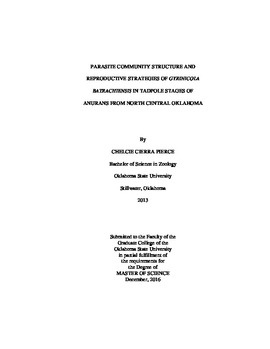| dc.description.abstract | Amphibians are commonly infected with parasites. As a result, they have been used as model systems to investigate parasite community structure in vertebrate hosts. Multiple factors have been identified to influence amphibian parasite community structure, including host size, habitat, and diet, as well as parasite transmission strategies. However, currently little information is available on how parasite communities are structured in tadpole stages of amphibians. The objectives of this thesis were to examine the parasite community structure of tadpoles of sympatric and syntopic anuran species from north central Oklahoma. Specifically, I investigated whether species-specific differences in tadpole size, feeding strategies, and habitat-use would affect parasite community structure. Additionally, I investigated the distribution and reproductive strategies of the tadpole pinworm, Gyrinicola batrachiensis, in tadpoles of five species of co-occurring anurans which differed in their time to metamorphosis. My data indicate that tadpole size is a primary factor in determining parasite abundances and intensities. However, after controlling for host size, parasite life history and host species were major factors in influencing parasite community structure within tadpole stages of anurans. Additionally, my study suggests that host species-specific differences, but not necessarily time to metamorphosis, play a major role on the growth, development, and reproductive strategies exhibited by G. batrachiensis in different amphibian species. This work provides evidence that parasite communities of larval anurans differ in their structure from adult anurans. However, factors such as host size, diet, and habitat, as well as parasite transmission strategies, appear to play an important role in structuring parasite communities within anuran tadpoles. | |
